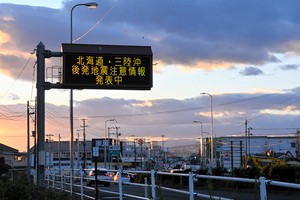By LISA VOGT/ Special to Asahi Weekly
June 6, 2023 at 08:00 JST
Izu Atagawa Onsen in Shizuoka Prefecture was believed to have been put on the map by Ohta Dokan (1432-86), a military tactician, samurai, Buddhist monk and, most famously, the man commended for his service in building Edo Castle. Ohta envisioned building an onsen spa when he observed an injured monkey bathing in hot springs there to ease its pain.
The springs are known to be one of the hottest in Japan, reaching the boiling point of 100 degrees. There are roughly 13 “yagura” hot spring towers around the town, releasing puffs of white steam, which is quite a sight.
The number of yagura per area is the highest in Japan. Next to Izu-Atagawa Station on the Izu Kyuko Line, you’ll see a 7-meter-high wooden yagura where you can boil eggs by submerging them in piping hot water for about 15 minutes. While you wait, you can enjoy a relaxing foot soak at this conveniently located barrier-free facility. Take a short stroll down to the beach and enjoy a scenic footbath gazing out at the ocean and the seven islands of Izu.
Closed shops, hotels, shooting galleries and game arcades hint that the area must have seen better times. Shuttered storefronts and old buildings in need of a fresh coat of paint dot the streets. Having said this, though, this kind of decay can make a town charming. There must be hundreds of places like this scattered throughout Japan.
Mention Atagawa to folks, and even if they’ve never set foot here, they will come up with the name “Atagawa Banana Wani En,” the Atagawa Tropical and Alligator Garden. The place houses a botanical park and many crocodiles, alligators and turtles. According to their website, it’s also the only place in Japan where you can see a Western Red Panda and Amazon Manatee.
The tropical park opened in 1958 and is ingeniously heated by Atagawa’s gushing hot spring water. With electricity costs skyrocketing these days, this visionary “eco” use of nature’s gift to this area to create a greenhouse for warm-temperature loving plants like air plants, orchids, water lilies, Victoria Amazonicas, bananas, mangos and more, gets a standing ovation from me.
For people sensitive to animal welfare issues, seeing crocs, gators and relatives of Teenage Mutant Ninjas penned up in tiny cramped enclosures might get you worked up. But considering that this place was conceived in the 1950s, it’s not fair to judge them harshly using today’s standards.
Atagawa is less than two hours by train from Tokyo.
* * *
This article by Lisa Vogt, a Washington-born and Tokyo-based photographer, originally appeared in the March 19 issue of Asahi Weekly. It is part of the series "Lisa’s Wanderings Around Japan," which depicts various places across the country through the perspective of the author, a professor at Meiji University.
This is the last installment of Lisa’s Wanderings Around Japan series.




















A peek through the music industry’s curtain at the producers who harnessed social media to help their idols go global.
A series based on diplomatic documents declassified by Japan’s Foreign Ministry
Here is a collection of first-hand accounts by “hibakusha” atomic bomb survivors.
Cooking experts, chefs and others involved in the field of food introduce their special recipes intertwined with their paths in life.
A series about Japanese-Americans and their memories of World War II